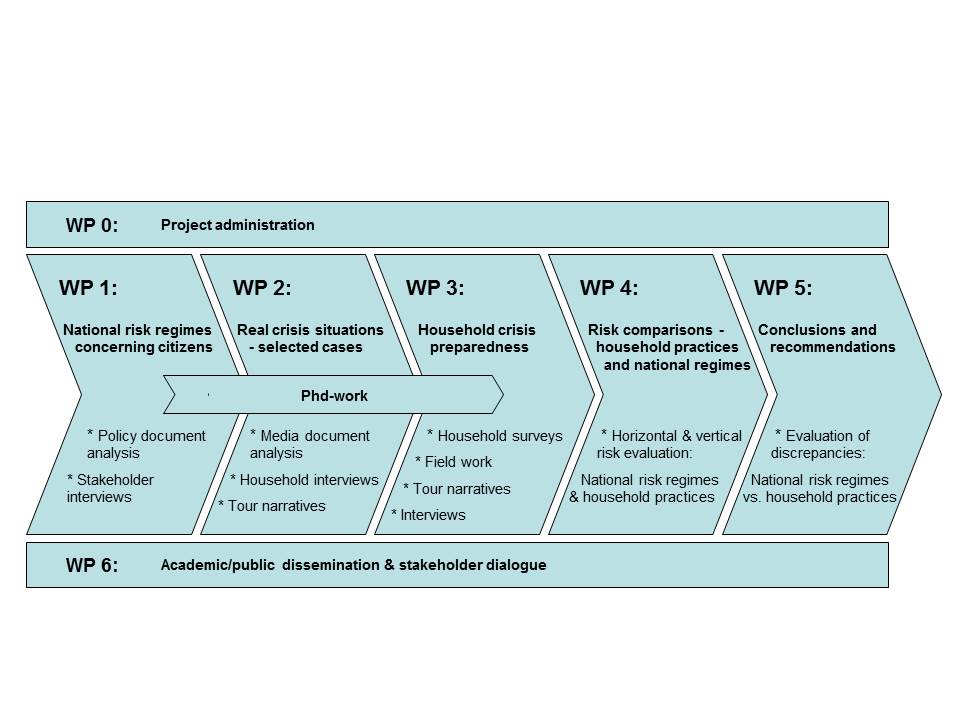Work packages
The HOMERISK project seeks to explore how households (as a core site for citizen-consumers), local communities and other informal networks are perceived as actors in societal risk management.
A comparative perspective is applied along two dimensions; risk perception and actual preparedness on the household as well as the governmental level, along with other central actors (vertical), and between Norway, Sweden and Iceland (horizontal). Key actors, structures and perspectives are reflected in the organisation of the work packages below (which also are related to the different research questions (RQs).
WP 0: Project administration
Main Objective: To secure a smooth running of the project.
Description of work: This WP will facilitate productive interactions between partners to ensure optimal academic results. The project will be monitored to ensure that the project is kept within the project frames, as set out in the project proposal and later in the contract. A kick-off meeting with all partners will take place at the outset of the project, and later various project meetings will be held according to plans. Establish a website for the project.
Output: Proceedings from internal project meetings, financial reports and documentation of the project progress. Maintenance of the project website where results are communicated.
WP 1: National risk regimes: The role of Citizens
Main Objective: To identify the expectations and responsibility of citizens in national risk plans in Norway, Sweden and Iceland.
Description of work: Document content analysis of available emergency plans, as well as interviews with key personnel, will be conducted in all three countries, focusing on the anticipated role of households and citizens. Methods: Document content analysis & Qualitative (semi-structured conversational) interviews.
Output: conference paper, position paper/report, article.
WP 2: Cases: The actions of citizens in concrete crises
Main Objective: To study two selected cases in each country (cf. above, section 2.1.).
Description of work: Use various qualitative methods to map, interpret and analyse how households have handled actual crisis situations with special emphasis on kin and neighbourhood networks. Data gathering will cover both practices and attitudes and be in situ (in households) for maximal data reliability. An appropriate number of households will be selected in each site/country. Methods: Tour narratives & Qualitative (semi-structured conversational) interviews.
Output: conference paper, 4 articles.
WP 3: Households’ preparedness for crisis events
Main Objective: Generate insights into the actual preparedness in households in case of a power failure, and to identify the potential of local networks.
Description of work: This task is the most extensive in the project, as we consider such knowledge to be crucial for the project’s goal. We will apply both quantitative and qualitative methods; a national survey will be conducted in all countries, focusing on questions of responsibility, governmental trust, formal and informal networks, and the accessibility of necessary equipment in case of emergency. In Norway, fieldwork will be conducted in 20 households, half rural, half urban, and selected from criteria developed in the initial stage of the project. This WP represents a substantial part of the PhD work. Approximately five households will be selected in Sweden and Iceland. Methods: Field work, Tour narratives, Survey & Qualitative (semi-structured conversational) interviews.
Output: 2 conference papers, 1 report, 4-5 articles.
WP 4: Risk comparisons; households and national regimes
Main Objective: Maximize the value of the findings by systematic vertical and horizontal) comparisons; reveal possible mismatches between plans and actions.
Description of work: Systematic comparisons of data from WPs 1-3: similarities and differences in (i) the relationship between authorities and households’ management in each country; (ii) national plans in all three countries; and (iii) households’ risk management in all three countries. Methods: Field work, Tour narratives, Survey, Document content analysis & Qualitative (semi-structured conversational) interviews.
Output: 4 articles.
WP 5: Conclusion and recommendations
Main Objective: To analyse and synthesise the results from the empirical work packages, integrating empirical and theoretical conclusions, and to formulate political recommendations.
Description of work: The data collected and analysed in the former WPs will be synthesized. In addition risk management will be debated with relevant stakeholders (the directorate for civil protection, counties and municipalities, fire and police departments, energy and communication companies, etc.). Households’ preparedness will be juxtaposed to stakeholders’ expectations. Stakeholder interviews will be conducted in all countries. On this basis a set of policy recommendations will be presented. These recommendations will focus on i) the empowerment of citizens in the risk management strategies and ii) the need to develop structures where it is possible for individuals to take control in societal crises.
Output: Final project report. Also developed into shorter policy briefs and recommendations for stakeholders.
WP 6: Academic & public dissemination and stakeholder dialogues
Main Objective: To communicate the process and project results to all groups of end users as well as to the scientific community.
Description of work: Results will be communicated to the projects’ end users (policy makers, local communities and the general public) in the form of reports and dialogues. The advisory board will take part in identifying the main stakeholder groups and serve as the main platform for communication with this user group. The main dissemination activity towards the general public is an exhibition at the Norwegian Museum of Science and Technology, called “When the nets break down”. All researchers in the project will publish in academic journals, some individually, some in collaboration.
Output: Academic dissemination is presented under WP 1-5. User dissemination also includes an Exhibiton at Norwegian Museum of Science and Technology to disseminate findings and communicate with wider public.
